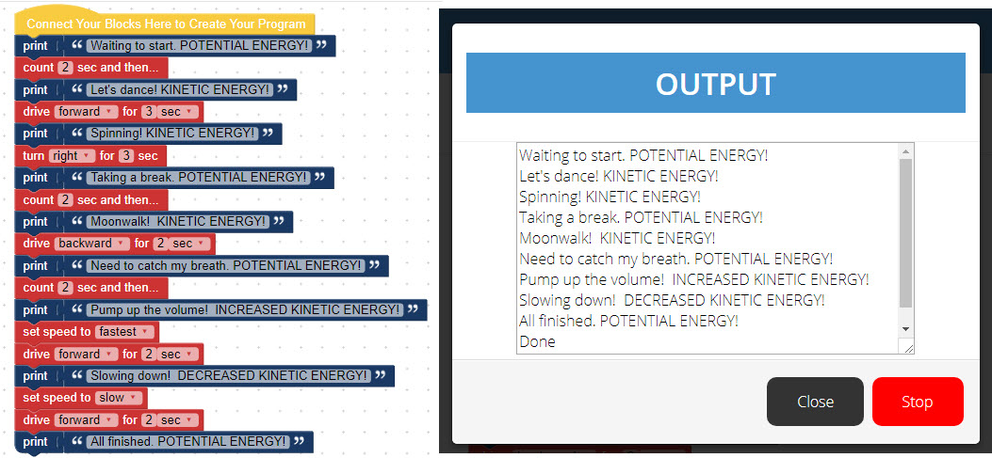Lesson 1: Energy Transformations - Dance Party!
The students will identify and describe kinetic energy, potential energy, and the Law of Conservation of Energy.
Setup
- Copy student handouts
- Open and/or download the Kinetic and Potential Energy slideshow
Attachments:
Introduction
- Ask the students, “How do you get energy?”
- Show the Kinetic and Potential Energy slideshow. Slide 2 - Read the definition of energy to the class- Energy is the ability to do work. Ask the students, “What do you think the definition means?
Procedure
- Explain that energy occurs in many different forms. In this lesson, the class will be learning about kinetic and potential energy.
- Show the kinetic energy slide (Slide 3). Read the definition to the class- Kinetic energy is energy associated with motion. Ask the students, “Which of the following pictures show kinetic energy?” Give students 2-3 minutes to think and write down their ideas on the student handout. Then, facilitate a class discussion about which pictures show kinetic energy. GoPiGo - If it is stationary it does not have kinetic energy. If it is moving, then it does have kinetic energy. Runners - kinetic energy; Lightning - kinetic energy; Wave - kinetic energ;y Surfer - kinetic energy; Car - If it is parked it does not have kinetic energy. If it is moving, then it does have kinetic energy
- Ask the class, “What are some other examples of kinetic energy?”
- Show the potential energy slide (Slide 4). Read the definition to the class- Potential energy is the amount of energy a thing has because of its position or the arrangement of its parts; stored energy. Ask the students, “Which of the following pictures show potential energy?” Give students 2-3 minutes to think and write down their ideas on the student handout. Then, facilitate a class discussion about which pictures show potential energy. GoPiGo - The batteries have potential energy, the GoPiGo has potential energy based on its location; Pie - potential energy; Car - potential energy (gasoline), the car has potential energy due to its position (is it on a hill?)
- Ask the class, “What are some other examples of potential energy?”
- Show the class the Energy in a Roller Coaster Ride interactive - http://www.pbslearningmedia.org/resource/hew06.sci.phys.maf.rollercoaster/energy-in-a-roller-coaster-ride/ . Discuss why the potential and kinetic energy increase and decrease throughout the ride.
- Explain the Law of Conservation of Energy to the class (Slide 5). Ask the students, how does this relate to kinetic and potential energy? Does the kinetic energy and potential energy just disappear when it decreases? Where does it go?
- Ask the students, “What is different about how roller coasters move and how a GoPiGo moves?” Discuss how roller coasters only use motors to ascend hills. They do not always have power. The GoPiGo only moves when the motors are running. It cannot roll down a hill on its own. Without the motors, the GoPiGo would roll down a hill freely.
- Ask the students, when does the GoPiGo have potential energy? When does it have kinetic energy? How can you increase or decrease the kinetic and potential energy of the GoPiGo? Kinetic energy can be increased by increasing the speed or by adding weight to the GoPiGo. The GoPiGo does move faster down a hill, but it does not roll down freely. It is still powered by the motors. This means that the kinetic energy is increased, but not the same way as a roller coaster.
- Tell the students that they are going to program their robots to complete a 20-30 second dance routine to show kinetic and potential energy. Students will work in groups of 2-3 write the “dance” code for their robot in Bloxter. Students will use the print block and "_" block together to describe type of energy that is currently being used. Pre-select music or allow students to choose their own music (Youtube or their own music). An example program is pictured below.
- Give students 5-10 minutes to plan their scripts on paper as a group or individually (student handout).
- Students will then use Bloxter to program their GoPiGo to perform a dance. Remind the students include blocks to say what kind of energy is currently being used. Siince a speakers is not connected to the robot, they will do that using the print block connected to a "__" block with their text inside of the quotes. Circulate around the room and assist students as needed. (20-30 minutes).
- Students will present their robot dance to the class and explain the energy transformations.

Closure
- Say to students, “Today we learned about two different types of energy, potential and kinetic, and how they are transformed. We also learned about the Law of Conservation of Energy. Next, we will learn about six other types of energy and how they transform from one type to another.”
- Students will then complete the 3, 2, 1 exit ticket independently.
Last modified: Tuesday, 10 November 2020, 1:54 PM